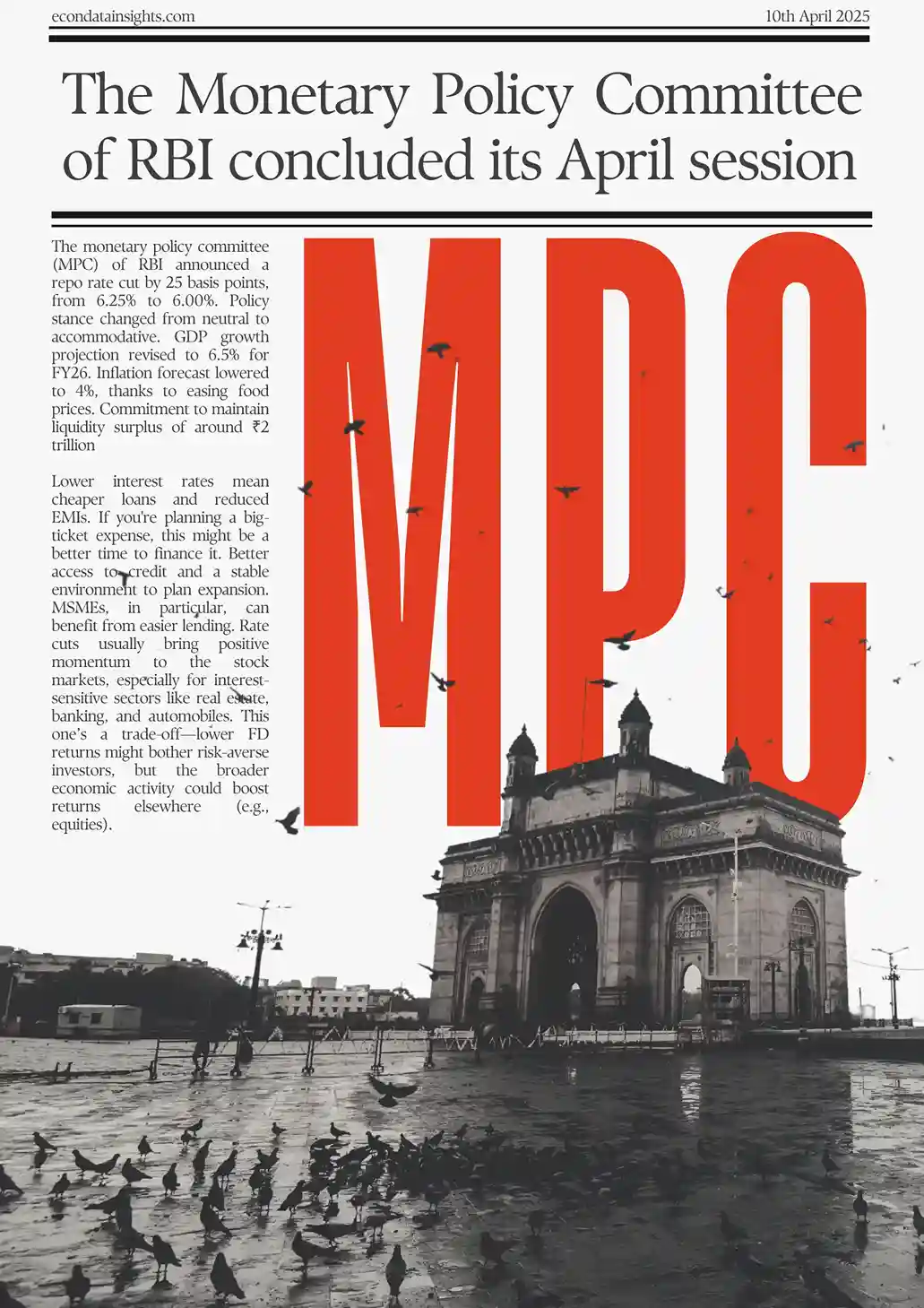On April 9, 2025, the Reserve Bank of India (RBI) delivered a policy that leans in favor of growth, giving both households and businesses something to think about. India’s economy is walking a tightrope—balancing the need for growth, the risk of global headwinds, and the aim to keep inflation under control.
In this post, we’ll walk you through what the central bank announced, what it really means in simple terms, and how it could impact all of us—from policymakers to college students, startups to savers.
🔑 Key Takeaways from the Policy
Let’s start with the main announcements:
1. Repo rate cut by 25 basis points, from 6.25% to 6.00%.
2. Policy stance changed from neutral to accommodative.
3. GDP growth projection revised to 6.5% for FY26.
4. Inflation forecast lowered to 4%, thanks to easing food prices.
5. Commitment to maintain liquidity surplus of around ₹2 trillion.
On the surface, these look like standard macroeconomic decisions. But what’s beneath these headlines? Let’s break it down.
🧠 What Does This All Mean?
📉 A Cut in Repo Rate – More Breathing Space for Borrowers
The repo rate is the rate at which banks borrow from the RBI. When the RBI cuts this rate, it becomes cheaper for banks to borrow, and they pass this on to consumers by reducing interest rates on loans.
Why it matters:
- EMIs on home, car, education, and business loans may go down
- Lower rates can boost consumer spending
- Encourages businesses to borrow and invest
👉 Think of it like a domino effect: lower repo → lower bank rates → higher demand → better growth.
🤝 Accommodative Stance – RBI’s Way of Saying “We’ve Got Your Back”
By shifting to an accommodative stance, the RBI is signaling that it’s open to cutting rates further if needed. It’s essentially creating room to support growth in the months to come.
This is particularly relevant now, because:
- The U.S. has imposed 26% tariffs on Indian exports, which could hurt our trade-driven sectors
- Domestic demand is steady, but not robust
- Inflation is within control, so there’s space to stimulate growth
The central bank is being proactive—not just reacting to the present but preparing for possible turbulence ahead.
📊 Lower Growth and Inflation Forecasts – A Realistic Outlook
The RBI has trimmed its GDP growth forecast for FY26 to 6.5%, from 6.7%. While this seems modest, it’s a reflection of caution—not panic.
Meanwhile, inflation is expected to stay around 4%, which is below the RBI’s upper comfort zone of 6%.
This combination gives RBI a sweet spot:
- Growth needs a nudge
- Inflation is not a threat
- So, let’s support the economy with lower rates
In policy circles, this is what they call a “window of opportunity.”
💧 Liquidity Support – Keeping the Financial Wheels Turning
The RBI has pledged to maintain a liquidity surplus of ₹2 trillion, about 1% of the total bank deposits in the system.
In simple terms: there’s plenty of cash in the system for banks to lend.
For the economy, this means:
- No credit crunches
- Small and mid-sized firms can access working capital easily
- Investors stay confident in the stability of the financial system
🔄 So, Why Now?
Two big reasons:
- External pressures are rising – especially with geopolitical risks and global trade tensions (like the U.S. tariffs on Indian goods).
- India’s growth needs a gentle push – not a full-blown stimulus, but some carefully crafted support.
The RBI has decided to step in just early enough to guide the economy gently through upcoming uncertainty.
👨👩👦 Who Benefits from This?
Let’s bring it closer to home.
✅ Borrowers: Lower interest rates could mean cheaper loans and reduced EMIs. If you’re planning a big-ticket expense, this might be a better time to finance it.
✅ Businesses: Better access to credit and a stable environment to plan expansion. MSMEs, in particular, can benefit from easier lending.
✅ Investors: Rate cuts usually bring positive momentum to the stock markets, especially for interest-sensitive sectors like real estate, banking, and automobiles.
⚠️ Savers: This one’s a trade-off—lower FD returns might bother risk-averse investors, but the broader economic activity could boost returns elsewhere (e.g., equities).
✍️ Wrapping Up: A Well-Timed Call
The April 2025 monetary policy is not just another quarterly update—it’s a well-timed intervention. At a time when global uncertainties are on the rise, and the domestic economy needs a nudge, the RBI has chosen to be pragmatic and forward-looking.
It’s saying, in essence:
“We’re watching the road ahead carefully. And we’re ready to act, not just react.”
This kind of steady hand at the wheel is crucial for maintaining investor confidence, public trust, and economic momentum. Whether you’re in policy, business, or simply managing your personal finances—this policy has something in it for everyone.
✒️ What’s your take on this move by the RBI? Do you think it’s enough, or should the central bank have done more? Drop your thoughts in the comments.
📊 Want to dive deeper? I’ll be publishing a breakdown of how past rate cuts impacted key sectors over the last decade. Stay tuned!
References

